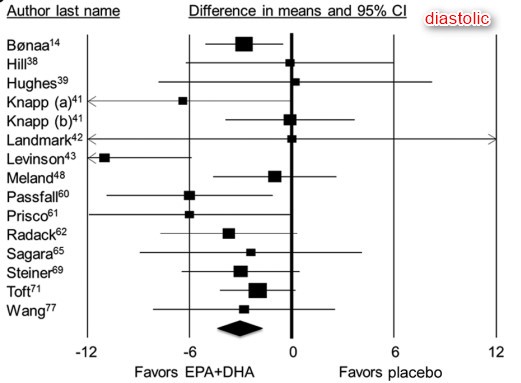Hypertension reduced by Omega-3, especially if previously untreated – meta-analysis
Long-chain omega-3 fatty acids eicosapentaenoic acid and docosahexaenoic acid and blood pressure: a meta-analysis of randomized controlled trials.
Am J Hypertens. 2014 Jul;27(7):885-96. doi: 10.1093/ajh/hpu024. Epub 2014 Mar 6.
Miller PE1, Van Elswyk M2, Alexander DD3.
1Center for Epidemiology, Biostatistics, and Computational Biology, Exponent, Inc, Chicago, Illinois; pmiller@exponent.com.
2Van Elswyk Consulting, Inc, Longmont, Colorado;
3Center for Epidemiology, Biostatistics, and Computational Biology, Exponent, Inc, Boulder, Colorado.



BACKGROUND:
Although a large body of literature has been devoted to examining the relationship between eicosapentaenoic and docosahexaenoic acids (EPA+DHA) and blood pressure, past systematic reviews have been hampered by narrow inclusion criteria and a limited scope of analytical subgroups. In addition, no meta-analysis to date has captured the substantial volume of randomized controlled trials (RCTs) published in the past 2 years. The objective of this meta-analysis was to examine the effect of EPA+DHA, without upper dose limits and including food sources, on blood pressure in RCTs.
METHODS:
Random-effects meta-analyses were used to generate weighted group mean differences and 95% confidence intervals (CIs) between the EPA+DHA group and the placebo group. Analyses were conducted for subgroups defined by key subject or study characteristics.
RESULTS:
Seventy RCTs were included. Compared with placebo, EPA+DHA provision reduced
systolic blood pressure (-1.52 mm Hg; 95% confidence interval (CI) = -2.25 to -0.79) and
diastolic blood pressure (-0.99 mm Hg; 95% CI = -1.54 to -0.44)
in the meta-analyses of all studies combined.
The strongest effects of EPA+DHA were observed among untreated hypertensive subjects (systolic blood pressure = -4.51 mm Hg, 95% CI = -6.12 to -2.83; diastolic blood pressure = -3.05 mm Hg, 95% CI = -4.35 to - 1.74), although blood pressure also was lowered among normotensive subjects (systolic blood pressure = -1.25 mm Hg, 95% CI = -2.05 to -0.46; diastolic blood pressure = -0.62 mm Hg, 95% CI = -1.22 to -0.02).
CONCLUSIONS:
Overall, available evidence from RCTs indicates that provision of EPA+DHA reduces systolic blood pressure, while provision of ≥2 grams reduces diastolic blood pressure.
© The Author 2014. Published by Oxford University Press on behalf of the American Journal of Hypertension.
PMID: 24610882
📄 Download the PDF from VitaminDWiki.
Omega-3 and Cardiovascular – review Sept 2013
Role of omega-3 fatty acids in obesity, metabolic syndrome, and cardiovascular diseases: a review of the evidence.
J Physiol Biochem. 2013 Sep;69(3):633-51. doi: 10.1007/s13105-013-0265-4. Epub 2013 Jun 22.
Lorente-Cebrián S1, Costa AG, Navas-Carretero S, Zabala M, Martínez JA, Moreno-Aliaga MJ.
The present review aims to illustrate current knowledge about the efficacy of omega-3 long-chain polyunsaturated fatty acids (n-3 LC-PUFAs) in treating/preventing several metabolic pathologies. We reviewed systematically the published evidence on the effectiveness of n-3 LC-PUFAs fish consumption or n-3 LC-PUFAs supplementation on prevention/treatment of obesity, metabolic syndrome, and cardiovascular diseases. Most of the reviewed studies were randomized-controlled interventional trials, although some relevant prospective and cross-sectional studies as well as some meta-analysis were also reviewed. Supplementation with n-3 LC-PUFAs might improve some obesity-associated metabolic syndrome features such as insulin resistance, hypertension and dyslipidemia by decreasing plasma triglycerides. Moreover, the blood pressure-lowering and anti-inflammatory properties of these fatty acids and their benefits in vascular function might confer cardioprotection. However, the efficacy of n-3 LC-PUFA on reducing myocardial infarction, arrhythmia, cardiac and sudden death, or stroke is controversial. Due to the beneficial actions of n-3 LC-PUFAs, several worldwide government and health organizations have established some recommendations of n-3 LC-PUFAs intake for groups of population. In general, the recommended levels for diseases prevention are lower than those advised for particular treatments. However, more clinical trials are necessary to recommend the most effective dosages and formulas (type of n-3 LC-PUFA, EPA/DHA ratio) for specific pathologies.
PMID: 23794360
